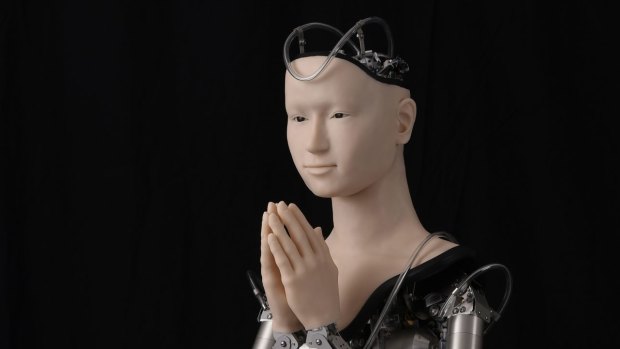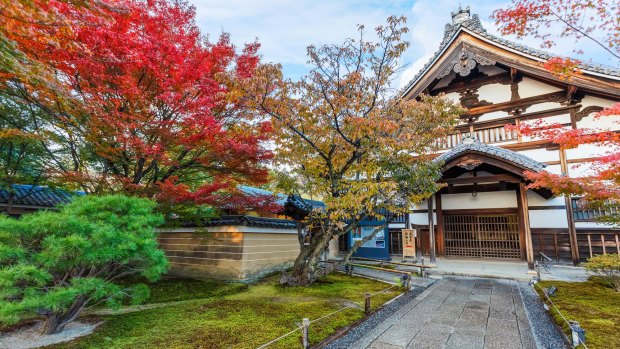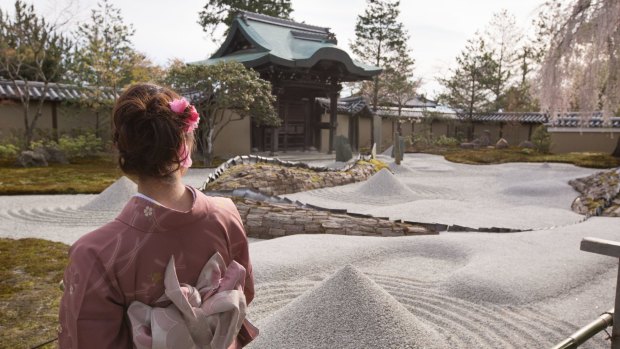This was published 6 years ago
Japan, Kyoto: Kodai-ji Zen Temple's resident robot teacher of Buddhist thought

Mindar, a robot bodhisattva and teacher of Buddhism, gives daily performances.Credit: S.Shiraiwa
Kodai-ji isn't a place you'd expect to find a robot, let alone one with a wasp waist, seductive voice and geisha-pale cheeks. This is a temple founded in 1606 in memory of Japan's great unifying hero Toyotomi Hideyoshi. His wife Nene is buried in the grounds, which are famed for their Zen gardens, laid out by 17th-century master landscaper Kobori Enshu. A great tea-ceremony master designed the temple's dainty teahouse.
Chief administrator Goto Tensho isn't weighed down by such pedigree, however. It's not about what you can see, but about what you can't see, he says, waving away Kodai-ji's gorgeous architecture and serene raked-gravel courtyards. There are four sufferings – birth, ageing, disease and death. What we should really be contemplating, he says, is how to escape them.
"But it's very difficult, and I'm too old to teach these things now. So, I think, why can't a robot do it instead?"

Kodai-ji is famed for its Zen gardens.Credit: Alamy
Enter Mindar, the temple's just-launched robot bodhisattva and teacher of Buddhism. I find her in a new temple hall, where she gives daily performances. Only her neck and face are humanoid, though stretched and rubbery as the face of a cosmetic surgery addict. The rest is all metal and plastic tubing, glittering with blinking lights. Mindar has a suggestion of breasts, slim waist and a snow-white neck that could inspire a haiku. She's oddly attractive.
"If you can abandon feelings of attachment, then desire does not arise," admonishes Mindar in gentle tones, as if reading my thoughts. "This is what the Buddha meant when he referred to emptiness."
I start to pay more attention to her words as she runs through the Buddhist concepts of emptiness and the mutability of mind and body. Is there an essential personality that we each possess? Does a never-changing self really exist? Why do we cling to a selfish sense of ego?

Kodai-ji's serene raked-gravel courtyards.Credit: Alamy
These are head-scratching questions, but Mindar presents them clearly and succinctly, using easy analogies such as that of a sapling, which grows into a tree and finally sheds leaves and decays. I'm drawn in. I've been to dozens of Kyoto temples, but have never learned much about Buddhism. Kodai-ji's robot takes me beyond simple sightseeing, into an exploration of the philosophy behind all the impressive architecture and garden landscaping.
I like, too, this latest example of the fusion of tradition and high-tech that places Japan among my favourite destinations. There's already a Japanese word, robotera, for temple robot classes set up to foster interest in Buddhism among Japanese children, with some success. This is something different, though. This isn't behind-the-scenes but aimed squarely at tourists and temple visitors, right in the middle of a major historical temple in Kyoto's venerable Eastern Hills temple district.
This attempt by Kodai-ji Temple to bring Buddhism into the 21st century without abandoning its core message is bound to ruffle feathers. Kodai-ji is used to that. Traditionalists frowned when it introduced evening illuminations in its grounds. Last year, they scowled when the temple held an exhibition of works by fabled manga artist Katsuya Terada.
Innovation is nothing new in Kyoto, however. It was the first city in Japan to adopt gas lighting and trams, and is home to electronics giant Kyocera and video-game company Nintendo. It's a city that has always had to reinvent itself.
"Kyoto has had a lot of disasters in its history," says Godo Tensho. "So never mind the old buildings. The energy of Kyoto is about getting up and trying again. You have to surprise people."
TRIP NOTES
MORE
FLY
Japan Airlines flies from Melbourne and Sydney to Osaka, an hour by train from Kyoto. See jal.com
TRAIN
A Japan Rail Pass is an easy way to use Japan's outstanding train system. Rail Europe sells passes from $390 an adult. See railplus.com.au
STAY
Ryokan Yoshida-Sanso overlooks the Eastern Hills temple district. Rooms from $447 a person including breakfast and kaiseki dinner. See yoshida-sanso.com
VISIT
Kodai-ji Temple is open daily, 9am to 5pm. Admission ¥600. See kodaiji.com
Brian Johnston travelled as a guest of Japan Airlines, Rail Europe and Kyoto City Tourism Association.
Sign up for the Traveller Deals newsletter
Get exclusive travel deals delivered straight to your inbox. Sign up now.